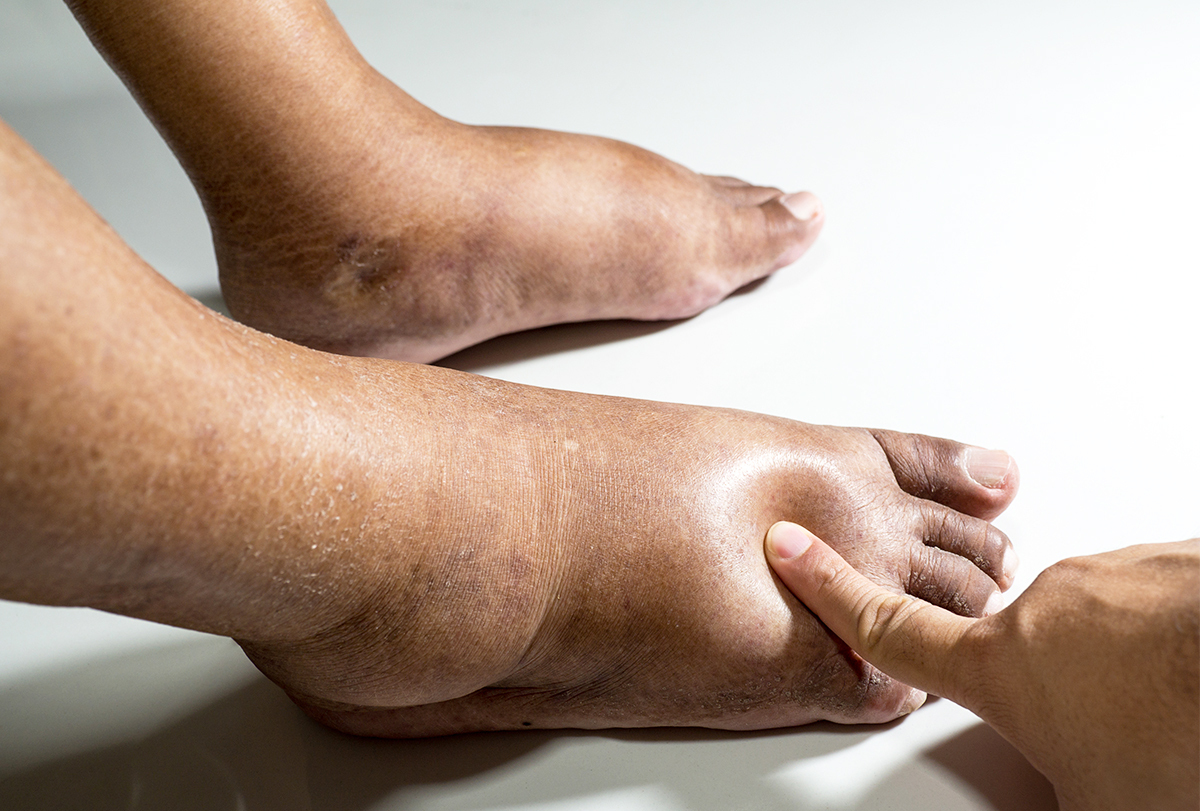Caring For Seniors With Edema

Swelling of the legs, feet and ankles is referred to as edema. Edema is the trapping of excess fluid in any part of the body’s tissues, from hands to feet, and is typically triggered by an excess build-up of fluid that’s trapped in the body’s tissues. Some recognizable signs of edema include:
- Swelling/puffiness of the tissue directly under your skin (common in legs or arms)
- Stretched or shiny skin around the affected area
- Skin that retains a dimple (pits), after being pressed for several seconds
- Increased abdominal size
What Happens if Edema Is Left Untreated?
If left untreated, it could result in painful swelling, difficulty walking, stiffness, stretched/itchy skin, scarring, poor blood circulation, and reduced elasticity in arteries, veins, and joints. Extreme cases can lead to skin ulcers and skin infections like cellulitis. Edema can also be a symptom of a previous untreated condition in the person, which usually centres around the heart, the lungs, the brain, or in other locations as well.
How to Manage Edema?
If you have a senior or a patient who is prone to edema at home, there are several minor lifestyle adjustments to help your loved ones prevent discomfort and serious complications.
a) Low-Sodium, Diuretic Rich Meals
A low-sodium diet is important for maintaining cardiovascular health and minimizing water retention as well. Encourage your loved one to use fresh herbs, citrus, and other sodium-free condiments and seasonings on their food to add flavor instead of reaching for the saltshaker. While the body needs salt to function properly, a physician or dietician can help you and your loved one devise a balanced and nutritious low-sodium diet that will help combat swelling.
Some foods naturally are able help balance fluid build-up, such as asparagus, parsley, beets, grapes, green beans, leafy greens, pineapple, pumpkin, onion, leeks and garlic. These foods have diuretic properties, which enables increased excretion of water from our bodies. Aside from their diuretic effects, these foods are also excellent sources of vitamins, minerals, fiber and antioxidants.
b) Compression Therapy
If your loved one has a specific limb or area that is affected by edema, it could be beneficial for them to wear a compression clothing (socks, sleeves, shirt, pants, etc.) Placing added pressure on the area during the day can prevent fluid from collecting there. These products come in a range of compression levels and it is important to work with a physician to make sure the product fits properly and provides the right amount of pressure. These garments can be somewhat difficult to put on and take time to get used to, but they should never be painful or uncomfortable.
c) Skin Care
Even if your loved one’s edema is under control, their skin integrity may still be affected and will be painful and re prone to infection if not taken care of properly. To prevent cracking, fracturing, and injuries, keep the affected areas clean, dry, and well-conditioned, and cover them with clothes with a skin friendly fabric.
d) Elevation
During sleep, a slight elevation can be beneficial to reduce swelling and preventing pooling and improving circulation. There are several items, such as pillows, slings, and wedges, that can help support and comfort the part of the body that needs to be elevated.
e) Exercising
Moving around while having edema can hurt a bit, but it is necessary to help minimise swelling and remove excess fluid. Even the tiniest movements and exercises can help circulate blood and lymph and strengthen your cardiovascular system. Before starting a new physical fitness programme, consult with your loved one’s doctor if they have any other problems that prevents them from being active or if they require special treatment. In addition, a doctor or physical therapist may be able to recommend alternative activities to help alleviate symptoms.
f) Monitor and Limit Fluid Intake
Staying hydrated is an important aspect of our overall health. For someone who has a chronic health condition that causes edema, it is advisable to follow a monitored consumption of liquid.
There are a few different techniques done for this process. One method involves using a container that holds the daily allowance of liquid consumption for reference. With each serving of liquid that is consumed throughout the day, an equal amount of water is poured into the container. Once it is full, no more liquid should be consumed. Spacing out consumption times can help prevent the seniors from meeting the limit early in the day and becoming excessively thirsty later on. Another technique is to determine a set serving size of fluid to consume with each meal throughout the day, this of which is usually prescribed by a physician to adhere to strictly.
Conclusion
By understanding the underlying causes and symptoms of edema and consulting a health professional, along with some lifestyle changes, family caregivers should be able to keep their loved ones safe and comfortable at home and make edema a manageable thing.
Links
https://www.medicalnewstoday.com/articles/159111#complications
http://www.myhealth.gov.my/en/leg-swelling-or-oedema-in-elderly/
https://www.mayoclinic.org/diseases-conditions/edema/diagnosis-treatment/drc-20366532

Leave a Reply
Want to join the discussion?Feel free to contribute!